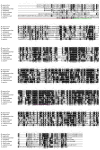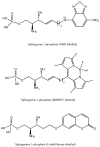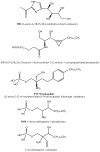Sphingosine 1-phosphate lyase, a key regulator of sphingosine 1-phosphate signaling and function
- PMID: 19914275
- PMCID: PMC2862839
- DOI: 10.1016/j.advenzreg.2009.10.024
Sphingosine 1-phosphate lyase, a key regulator of sphingosine 1-phosphate signaling and function
Figures




Similar articles
-
New aspects of sphingosine 1-phosphate signaling in mammalian cells.Adv Enzyme Regul. 2009;49(1):214-21. doi: 10.1016/j.advenzreg.2009.01.011. Adv Enzyme Regul. 2009. PMID: 19534035 Review. No abstract available.
-
Synthesis of a fluorogenic analogue of sphingosine-1-phosphate and its use to determine sphingosine-1-phosphate lyase activity.Chembiochem. 2009 Mar 23;10(5):820-2. doi: 10.1002/cbic.200800809. Chembiochem. 2009. PMID: 19226506 No abstract available.
-
Sphingosine-1-phosphate: boon and bane for the brain.Cell Physiol Biochem. 2014;34(1):148-57. doi: 10.1159/000362991. Epub 2014 Jun 16. Cell Physiol Biochem. 2014. PMID: 24977488 Review.
-
Sphingosine-1-phosphate lyase has a central role in the development of Dictyostelium discoideum.Development. 2001 Sep;128(18):3473-83. doi: 10.1242/dev.128.18.3473. Development. 2001. PMID: 11566853
-
Epigenetic regulation of pro-inflammatory cytokine secretion by sphingosine 1-phosphate (S1P) in acute lung injury: Role of S1P lyase.Adv Biol Regul. 2017 Jan;63:156-166. doi: 10.1016/j.jbior.2016.09.007. Epub 2016 Sep 29. Adv Biol Regul. 2017. PMID: 27720306 Free PMC article. Review.
Cited by
-
Heterogenous Nuclear Ribonucleoprotein H1 Promotes Colorectal Cancer Progression through the Stabilization of mRNA of Sphingosine-1-Phosphate Lyase 1.Int J Mol Sci. 2020 Jun 25;21(12):4514. doi: 10.3390/ijms21124514. Int J Mol Sci. 2020. PMID: 32630435 Free PMC article.
-
A Literature Review of Ozanimod Therapy in Inflammatory Bowel Disease: From Concept to Practical Application.Ther Clin Risk Manag. 2022 Sep 8;18:913-927. doi: 10.2147/TCRM.S336139. eCollection 2022. Ther Clin Risk Manag. 2022. PMID: 36106049 Free PMC article. Review.
-
Free-radical Destruction of Sphingolipids Resulting in 2-hexadecenal Formation.Lipid Insights. 2015 Mar 25;8:1-9. doi: 10.4137/LPI.S24081. eCollection 2015. Lipid Insights. 2015. PMID: 25861222 Free PMC article.
-
Treatment with THI, an inhibitor of sphingosine-1-phosphate lyase, modulates glycosphingolipid metabolism and results therapeutically effective in experimental models of Huntington's disease.Mol Ther. 2023 Jan 4;31(1):282-299. doi: 10.1016/j.ymthe.2022.09.004. Epub 2022 Sep 16. Mol Ther. 2023. PMID: 36116006 Free PMC article.
-
Sphingolipids in Ventilator Induced Lung Injury: Role of Sphingosine-1-Phosphate Lyase.Int J Mol Sci. 2018 Jan 1;19(1):114. doi: 10.3390/ijms19010114. Int J Mol Sci. 2018. PMID: 29301259 Free PMC article.
References
-
- Badalassi F, Wahler D, Klein G, Crotti P, Reymond J. A Versatile Periodate-Coupled Fluorogenic Assay for Hydrolytic Enzymes. Angewandte Chemie. 2000;39 (22):4067–70. - PubMed
-
- Bagdanoff JT, Donoviel MS, Nouraldeen A, Tarver J, Fu Q, Carlsen M, Jessop TC, Zhang H, Hazelwood J, Nguyen H, Baugh SD, Gardyan M, Terranova KM, Barbosa J, Yan J, Bednarz M, Layek S, Courtney LF, Taylor J, Digeorge-Foushee AM, Gopinathan S, Bruce D, Smith T, Moran L, O’Neill E, Kramer J, Lai Z, Kimball SD, Liu Q, Sun W, Yu S, Swaffield J, Wilson A, Main A, Carson KG, Oravecz T, Augeri DJ. Inhibition of sphingosine-1-phosphate lyase for the treatment of autoimmune disorders. J Med Chem. 2009;52 (13):3941–53. - PubMed
-
- Bandhuvula P, Fyrst H, Saba JD. A rapid fluorescence assay for sphingosine-1-phosphate lyase enzyme activity. J Lipid Res. 2007a;48 (12):2769–78. - PubMed
-
- Bandhuvula P, Saba JD. Sphingosine-1-phosphate lyase in immunity and cancer: silencing the siren. Trends Mol Med. 2007b;13 (5):210–7. - PubMed
Publication types
MeSH terms
Substances
Grants and funding
LinkOut - more resources
Full Text Sources
Other Literature Sources

